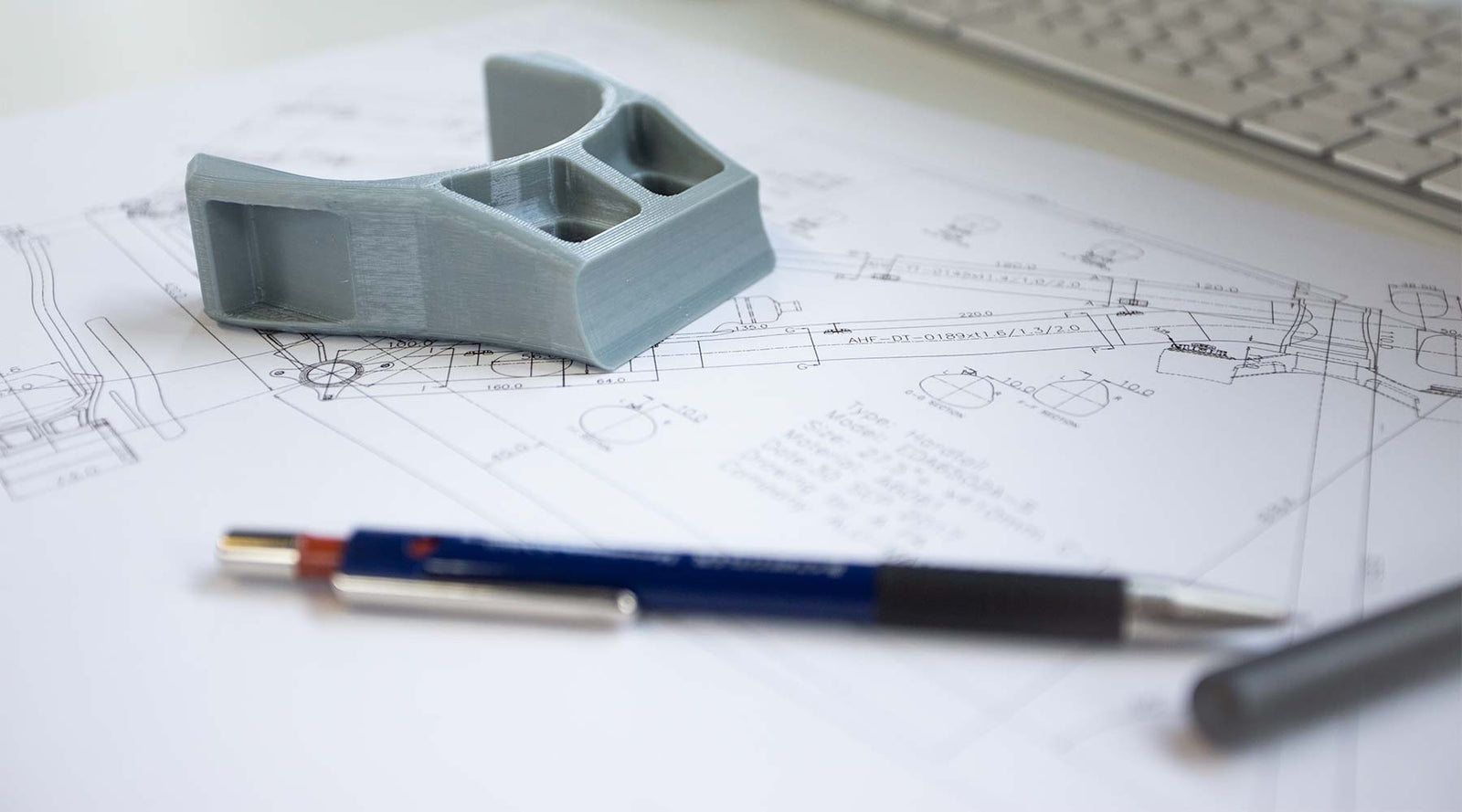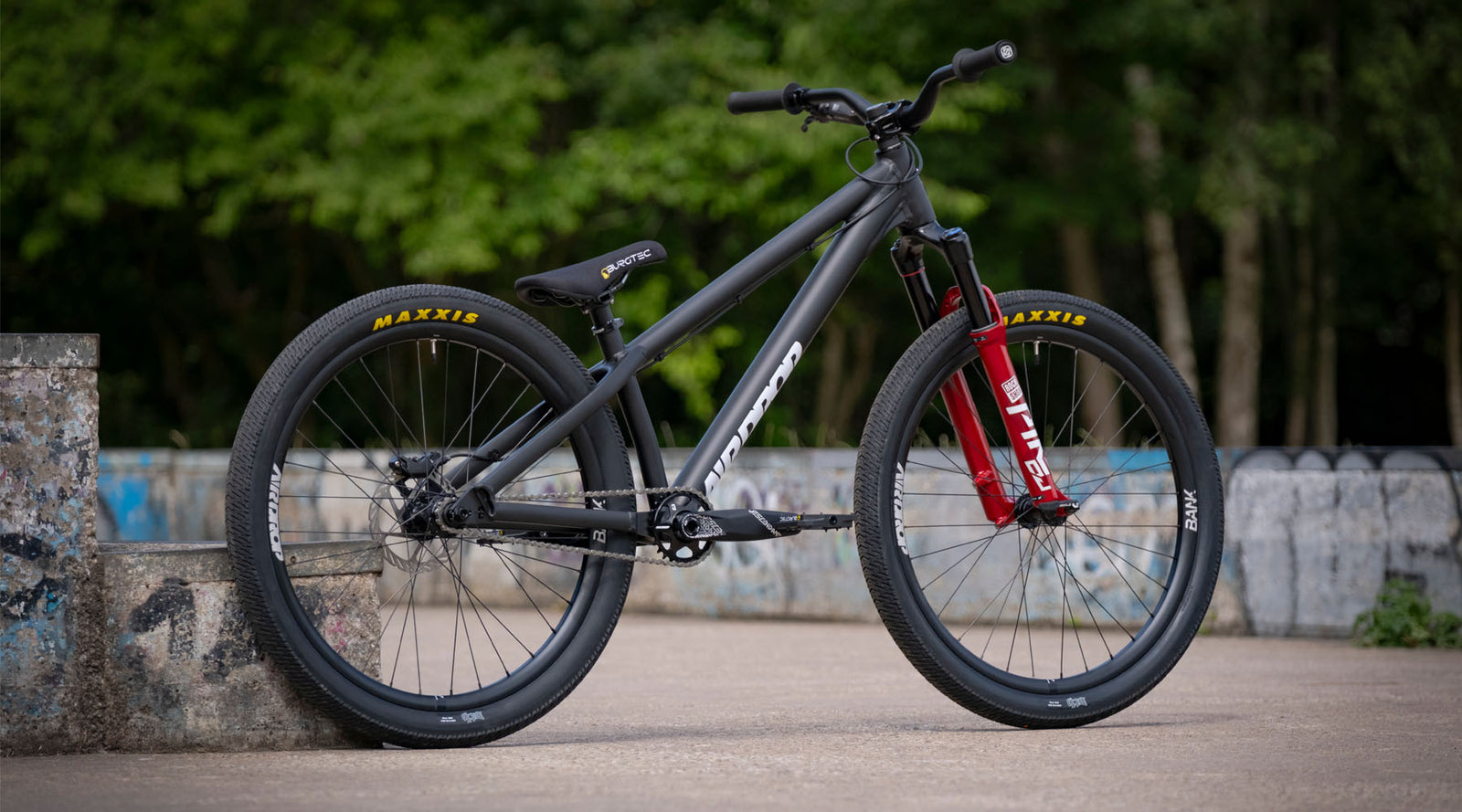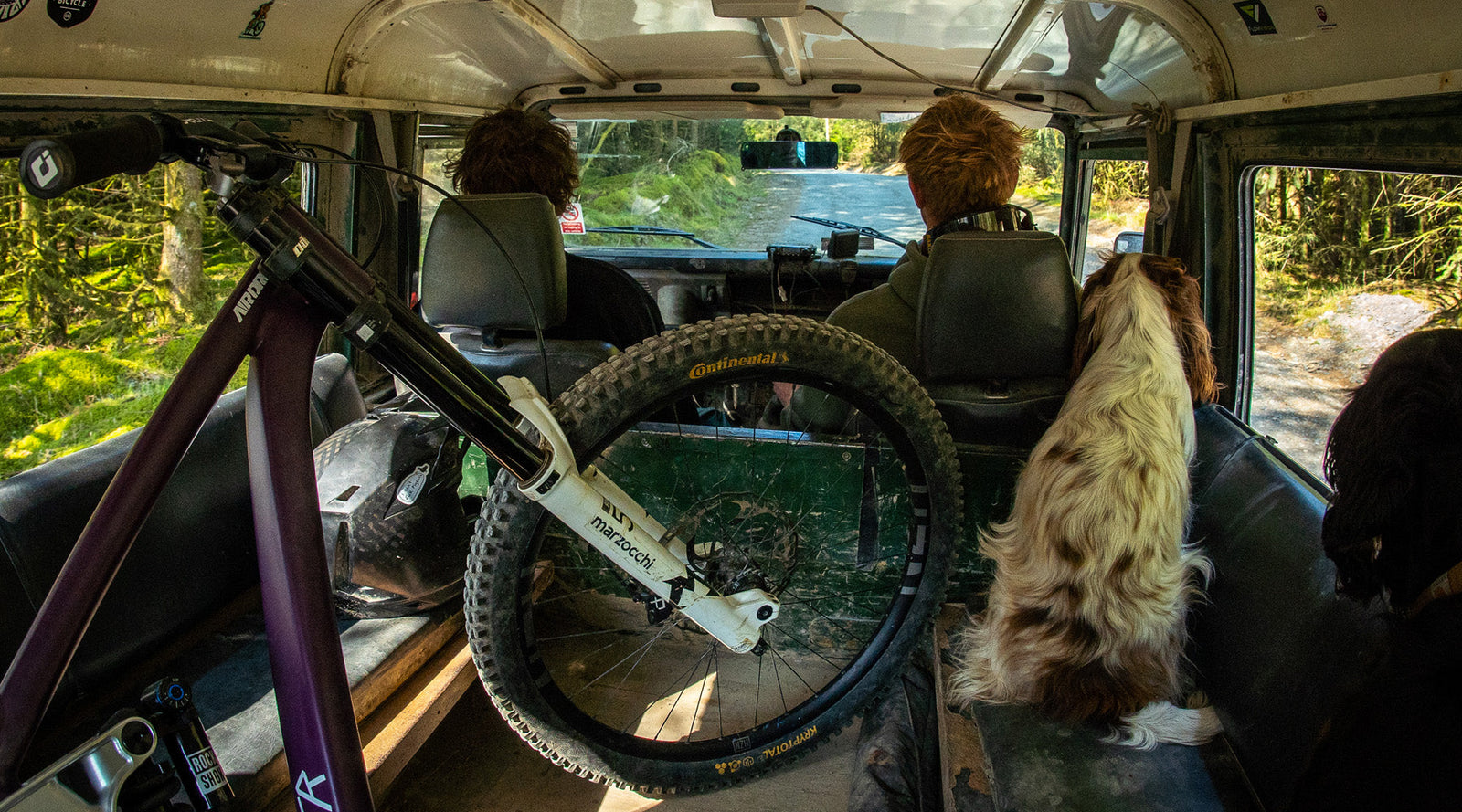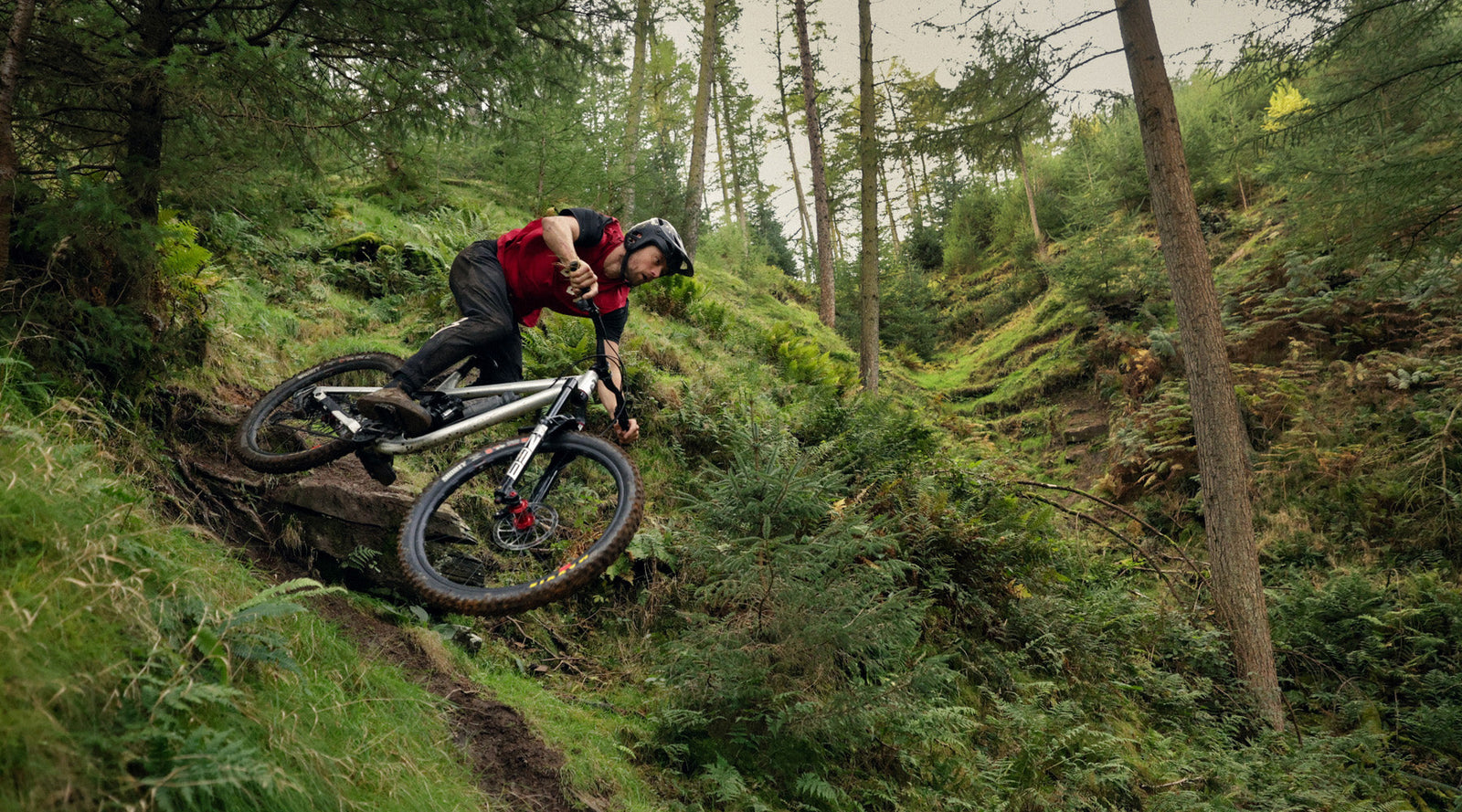
Developing The Bitmap
May 10, 2018
Last week we launched the Airdrop Bitmap, our new alloy hardtail. It's had a great response, so we though it would be good to get some insight into how we designed and developed it.
Loads of people want to know why we made the design decisions we did, and there have been a lot of questions, so we'll get into the detail of how we ended up with the design, geometry and feature set that the Bitmap has now. We might have been around for a couple of years now, but Airdrop is still just about as small as a bike company can be. That means launching a new bike is a seriously big undertaking for us, and every decision is critical. It's personal too, and we really sweat the details. Hopefully that shows in the finished product.

1: The Original Idea
You'll have noticed by now that Airdrop is a very personal thing for me. Although it's grown a bit and we haven't been in my garage for the last year, it's still basically driven by my long-held ambition to run my own bike brand. The inspiration for much of what we do and the motivation to make it happen comes from my own experience.

Roll back to Summer 1997. I was 16 years old and fully stoked on mountain biking. I was as obsessed with how the bikes were made and how they worked as I was riding them even back then, and for me, one brand stood out: Santa Cruz. You could get a Tazmon or a Heckler at that time, but they were on another planet; I couldn't even dream of getting a full suspension bike. And in any case, the suspension did't really work. I could only have one bike and what I wanted more than anything was a Chameleon; It stood out a mile with it's oversize 6000-series alloy tubing, low standover height and square chain stays. It was an aggressive hardtail unlike anything else I'd seen before, and I wanted one. But at £399 (I think) for frame only, I could never afford it. I ended up with a used 1992 Orange Clockwork which was a lovely bike, but very much an XC machine, and was already a bit behind the times in terms of geometry and standards.
2: Timeline
When I first launched Airdrop Bikes I decided to go with a full suspension bike first, the Edit. Conventional wisdom was to start small with a hardtail, which should have been easier to do. I chose to go with a 150mm bike and the rest is history, but I still wanted that hardtail I never got as a kid. Plus I'd set up a personal rule: I'm not allowed to buy another brand's bike. If I want a bike for myself, I have to design it and put it into production. A bit harsh maybe, but it's a good motivator. So if I ever wanted to get that hardtail, I had to get on with it.

As soon as the Edit went into production in late 2015, I started work on the Bitmap. I thought it was going to be easy - I had a pretty strong idea of what I wanted it to look like and the geometry I was after, but I underestimated how hard it would be to run the business, look after customers, build the bikes and also do the development work all by myself. It was a slow burner until James came in last Spring, which gave me the extra space I needed to get the Bitmap prototypes made.
We had first protos from the start of last Summer which gave us a great opportunity to get a lot of riding in and get everything really dialled. As a proof of concept the first versions were great and it was obvious that the Bitmap would be a winner, but it took a few iterations and a lot of refinement to get to the finished design. We ordered production tubing in November 2017.
3: Development Process
Looking back at the early sketches now, I didn't directly reference that early Chameleon but you can see the inspiration in there. I hope that the bike we have now is a worthy successor to that original Chameleon. It's an aggressive alloy hardtail, it's strong and light and can be built any way you like. The idea may be over 20 years old, but we've put everything we've learned about modern geometry and standards into the Bitmap, so it's very much a bike of it's time.
We sell alloy bikes and they're made in Taiwan, so they must be straight out of a catalogue, right? We occasionally get that accusation from some keyboard warrior, but I have had it said straight to my face. It would be a lot easier for us to just pick a frame and hand over some cash, that's for sure. But does anyone really think you can just go and get a frame this good from some factory? And even if you could, we'd miss out on one of the best bits of running your own bike company - the development. For me it's as much about the journey as the destination. Yes I wanted a hardtail but I also wanted to enjoy the process of designing, developing and testing one, and gaining all the knowledge and experience that brings. And then of course, the satisfaction of knowing it's something you've achieved for yourself.
The Bitmap started life in my head, then my sketchbook and from there through the computer renders to 2D and 3D, every part of it is authored by us.

After sketching out rough ideas on paper, some layouts are rendered in 2D on the computer. It's a good way to sanity check the ideas and communicate the concept to everyone involved in the project. When you start working to scale, you quickly pick up on issues that freehand sketching doesn't help with.

We also put a lot of work into the various different tubing junctions and tubing profiles. Partly this is important from an aesthetic point of view - for example I felt that retaining the seat-tube gusset style from the Edit would tie the two bikes in together and help them to look like they're related. It's also a relatively fast way to start addressing some of the engineering problems that might come up in 3D and later in production.

The next stage of development is to start building the frame in 3D. You can do this concurrently with developing geometry but we had a pretty clear idea of what we wanted from the beginning, and since there are no pivot locations and kinematics to deal with, we got into 3D quite early on. We do ask an industry friend to help out with some of this stuff, as much as anything to sanity check what we're doing: he has a lot more experience than we do and it gives us the confidence to go forward with our own ideas.
Our frames are made in small batches and we don't really have the kind of cash you need to open up forging tools. So we place a fair bit of emphasis on CNC machining to achieve what we need. The 3D design process and the ability that gives us to rapidly produce printed prototypes is incredibly productive. In the case of the Bitmap, we invested a lot of time into the CNC chain stay yoke.

We have a small 3D printing firm just round the corner so it's super convenient for us to have these made. Being able to hold a full scale physical prototype makes such a big difference to the design process, no to mention the ability to check for clearances etc. Here you can see a chain stay yoke - I think this is the second iteration - being produced, and the finished piece below:

In this case we had pocketed the outside of the yoke with three fins, but found that they would be likely to gather mud and be hard to clean, so we opened up this big pocket which would shed mud more easily.

Of course you can play around in 3D all you like, and having bits printed is great, but at some point the gains you can make in software slow down, and your desire to just go out and ride the thing takes over. We had physical prototypes from about this time last year. You can just about make out the original chain stay yoke design on this picture, before we made the changes.
"If a picture is worth 1000 words,
a prototype is worth 1000 meetings"
Tom & David Kelly, Ideo
After 20 years(!) of anticipation and a year and a half of development work, I was actually a bit nervous about riding the proto for the first time. Had we done everything right? Was it even a good idea? Slightly irrational I guess but having invested so much to get to that point it was a bit of a stress... until I got out on it for the first time. It's an experience I've had once or twice now; you build it up and set out for the first ride, and at the beginning you try to be analytical about it. You're thinking about the sizing, the geometry, how it feels, what it sounds like and so on. But your grin widens and before long you're just ripping around your local trails having a mint time on a new bike.
I really got into the Bitmap and set a habit of getting up at 5am and riding a couple of hours before my family woke up in the morning. I also took it with me in the van everywhere I went, which meant I could just grab a quick couple of laps of my local trails on the way back from a meeting, or just hoon around on it whenever the opportunity came up. It's a great bike for that. I pretty much rode my Bitmap exclusively all that Summer and considering I've got a beautiful Edit v2 to ride any time I like, that says a lot.
Design Decisions: Features of the Bitmap
Design is about problem solving, and designing something even as apparently simple as a hardtail frame involves the solving of a thousand small problems. And although we've had hardtails for a very long time, we've never designed one before. So we have to solve a whole bunch of problems for ourselves. That's not always apparent when we launch a new bike, and a lot of the rationale behind the design decisions gets lost. Then when the internet comments kick in, the answers to a whole bunch of questions aren't available. So it's worth taking a closer look at some of the major decisions we took when developing the Bitmap.
4: Material: 6061 Aluminium Alloy
I knew it was coming from day one. "If it's not steel, go home". We got that even before the Bitmap was officially launched. I guess it's understandable since there are some lovely steel frames out there. But there are also some truly awful steel frames too. It turns out that really good bikes are good because they're well designed by someone who understands the application of the right material to the task at hand.

For a bike like the Bitmap it was clear that alloy would always be the best material to use, and for me that's proven every time I ride it. In the Bitmap we've been able to deliver a premium hardtail frame with excellent geometry and ride characteristics; it's light enough, strong enough, stiff enough but still lively. It has CNC replaceable dropouts and brake mounts, a CNC rear axle and seat clamp included, and it still costs significantly less than an equivalent steel frame. Ultimately, it's very much an Airdrop bike and it shares much of the DNA that has made the Edit so popular. We've been able to build on the great relationship we've developed with our factory and they are just as proud of the outcome as we are.
5: Feature - Boost 12x148mm Rear Axle
When we developed the Edit, the Boost 148 rear axle standard was just about to happen. It wasn't clear if it was going to stick or not, and it was quite disruptive for the industry. We knew that a lot of our customers would be buying frames and building them with older kit, so we decided to stick with 12x142mm so that the Edit could be a platform for those builds.

A couple of years later and we're having the same conversation about the Bitmap, but circumstances have changed. Boost 148 is clearly now the standard, and many customers have a Boost equipped bike and are coming to us for a new frame. And the benefits of Boost 148 - especially to a hardtail like the Bitmap - are clear, especially when designing the chain stay yoke which is a critical element of the frame. It has enabled us to provide ample tyre clearance for a 27.5x2.6" tyre with loads of mud clearance, run a 420mm chainstay and still have ISO clearance for a 36t chainring. We couldn't have done that with 142mm rear axle spacing.
6: Feature - 2.6" Tyre Clearance
We're not calling the Bitmap a 'plus' bike, although it does have plenty of tyre clearance. We wanted the Bitmap to be a genuinely aggressive bike and the plus tyres we've ridden (in the 3" range) don't really offer the right qualities; there's too much tyre-roll and if you run them at the kind of pressures that you should, they can be incredibly bouncy.

What we are seeing now is a new generation of 2.6" tyres that offer an aggressive tread pattern, a strong enough casing and a high air volume without too much roll and a respectable weight. It's the right balance. So the Bitmap is designed to accommodate a 27.5x2.6" tyre and still offer a load of mud clearance, without making the compromises necessary to fit a 3" tyre.
7: Feature - Designed for 140mm Forks
The Bitmap was designed around a 140mm fork with an axle-crown length of 532mm. Different brands will vary a little, but basically a 140mm is the one. We reckon that's just about right for a trail bike; enough travel to be able to hit stuff hard, but not so much that the fork will dive too much and ruin the geometry. We've seen hardcore hardtails with up to 160mm forks, but typically that's done just to get a slack enough head angle and it compromises the bike in other ways. We designed the Bitmap to have a 65 degree head angle on that 140mm fork, and it works.
8: Feature - External Cable Routing
To be totally honest, I hate cables and hoses. They can make a real mess of an otherwise lovely bike, and if they're not set up perfectly things can get noisy. I like my bike to be silent. So I understand the temptation behind internal routing, but in my view it has more drawbacks than benefits, especially on an alloy bike. Better to have really well executed external routing - it's clean, quiet and easy to maintain. Keeping everything external is a very deliberate decision for us.
9: Feature - Airdrop Seat Clamp & Axle
When we were doing our research, one thing we picked up on was that other high-end hardtails are sometimes quoted without a rear axle. It's a bit sneaky when you have to pay another £50 on top of the price. We've always supplied our frames with axles so we wanted to make sure that it was included, and there was an opportunity to produce something ourselves.

Every Bitmap frame ships with our very own in-house designed CNC bolt-through rear axle. It works perfectly with our removable dropouts and is super-clean when installed. We also include our own CNC seat clamp, which I suppose isn't really necessary but it finishes things off beautifully and that's what I was always aiming for with Airdrop; to have a really complete product. Simple, clean and well executed.
The Complete Package
Hopefully that's given you a little insight into what went into bringing the Bitmap to life. Considering it's "just an alloy hardtail" we've put a lot of hard work and dedication in to get to this point. And that kind of is the point for me. I set out to produce something I can be really proud of and true satisfaction can only be earned through hard work. I hope you like the Bitmap as much as I do.

10: Outcome - the finished article
Suffice to say that the Bitmap is a bike that I'm personally extremely proud of. It's a huge commitment of time, energy and money to put something like this into production, and if I wasn't totally sure that it's a great bike, that wouldn't happen. When I say we've sweated the details, I mean that literally. It's far more than just a part of our range; one of many bikes that we've churned out en-masse. It's the realisation of a personal ambition and one of the main reasons why I quit my job to do this.
I won't rehearse all the details here, but I'd recommend taking a closer look at the Bitmap page which is packed with features and specs, and you can find links to all the different buying options below. You might also want to take a look at the geometry and sizing information.
11: Outcome - Buying Options
We sell the Bitmap as a frame only which as mentioned includes the CNC rear axle and CNC seat clamp. It's available in our own signature Raw finish which is hand brushed so that each one is unique, and clear-coated. There's also a grey finish which is back by popular demand from the original Edit v1. Right now we're offering more than a dozen different decal colours to choose from.
We also offer the Bitmap with three stock builds:
Airdrop Bitmap Trail: Bitmap frame with Rockshox Revelation forks, Reverb Stealth with 1x remote, SRAM NX groupset, Level TL hydraulic disc brakes, Hope Tech Pro 4 Enduro Wheelset and Truvativ Descendant 35 bar & stem. Finished with WTB tyres and our custom WTB saddle.
Airdrop Bitmap Pro: Bitmap frame with Rockshox Pike forks, Reverb Stealth with 1x remote, SRAM GX Eagle groupset, Guide R 4-pot hydraulic disc brakes, Hope Tech Pro 4 Enduro Wheelset and Truvativ Descendant 35 bar & stem. Finished with WTB tyres and our custom WTB saddle.
Airdrop Bitmap Works: Bitmap frame with Rockshox Pike forks, Reverb Stealth with 1x remote, SRAM X01 Eagle groupset with Descendant Carbon cranks, Guide RSC 4-pot hydraulic disc brakes, Hope Tech Pro 4 Enduro Wheelset and Truvativ Descendant 35 bar & stem. Finished with WTB tyres and our custom WTB saddle.
And last but by no means least, we have our specialist custom build service. All our bikes are built to order and what we've become known for is offering a full one-to-one custom build service where we work with you to get the spec dialled perfectly. If you're interested in taking a look at a custom build, contact us.
Ed Brazier
Ed is the owner of Airdrop Bikes. A former web and graphic designer, he sacked off his job one day and decided to start up a bike brand.
2 Responses
Murat Ali Gunes
May 15, 2018
Great looking and well designed frame, congrats Ed. I am thinking the Edit orange colour would be awesome for this hardtail. Can you not make 12×142 dropouts for this? Dropouts are replaceable so maybe you can make it a choice like some other brands. I for one have all non-boost components at hand and I don’t care where the industry is moving etc. I will keep things non-boost as long as I can. If you give the choice, I will get one definitely. Cheers
Leave a comment
Comments will be approved before showing up.
Also in Airdrop Bikes Blog

Fade Core Refresh
July 09, 2025
Rockshox recently released the Pike DJ to the new Electric Red colour. We like to make sure that we keep our bikes up to date, so we took the opportunity to give the Fade Core a bit of a refresh.

Into The Woods We Go
June 26, 2025
We took a trip down to Dyfi to catch up with Alf and get him on his new Slacker, then do a bit of digging & riding. Watch the video... Into The Woods We Go.
Read More

True North Demo Day
June 06, 2025
We've partnered up with True North Cycle Hub to give you the chance to demo an Edit MX in Wharncliffe Woods on Saturday 14th June, 2025.
Email Newsletter
Our monthly email newsletter gets you access to all the good stuff before everyone else.

Jack Goodbody
October 22, 2020
Good afternoon, I’m planning on building a new custom bike for my fiancé and I was wondering if you still see the airdrop bitmap frame